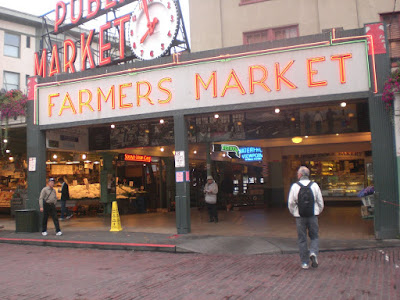
4. Smith Tower
6. Holly House and Hypatia in the Woods

Just south of Olympia, Washington, Hypatia in the Woods is a residential retreat and study center where women are offered peace and quiet to pursue artistic or academic work. Elspeth Pope created and runs it. The setting is lush acres of old forest land.

9. My local coffee joint

Even tastier than the coffee are the e-comments:
"I know of at least 2 women who choose not to patronize his shop due to the way in which he suggestively spoke to them and *hugged* them."
" ... every table was taken by single occupants staring blankly into their laptops. It was like a scene from a distopian novel."
"The owner is downright delicious to behold. It fits, since he was voted sexiest small business owner ..."
11. Pike Place Market
13. A bus every seven minutes

Just a few steps from my door is the Seattle Metro route 3/4 which comes every seven minutes.
(And you know you're a bus chick if ...)
14. My pals Elspeth and Vivian


Elspeth, creator of Hypatia in the Woods, suffered a stroke earlier this summer. She's making an extraordinary recovery because she knows she must get back to work.
15. Amtrak to Portland
16. Panama Hotel

 The Panama Hotel opened in 1910 to serve the working class and new arrivals in Seattle's Japantown. In the basement is a hashidate-yu -- a Japanese bath -- one of two remaining in the U.S. A recent owner discovered boxes in the basement that had been stored and never reclaimed by families who were interned in 1942. (More).
The Panama Hotel opened in 1910 to serve the working class and new arrivals in Seattle's Japantown. In the basement is a hashidate-yu -- a Japanese bath -- one of two remaining in the U.S. A recent owner discovered boxes in the basement that had been stored and never reclaimed by families who were interned in 1942. (More).
21. Sealth
22. My 'hood


Nowadays I live in the Central District of Seattle. This is the neighborhood that was once home to Quincy Jones and Jimi Hendrix.

23. My Cham friends
Rosalia, Ismael, and Dhung

Some history about the Cham people in Seattle, from Seattle Pacific University:

Some history about the Cham people in Seattle, from Seattle Pacific University:
A unique presence that distinguishes the Muslim community in Seattle is that of several hundred Chams, Muslims from Vietnam and Cambodia. They first arrived in Seattle in 1978, fleeing the Khmer Rouge and the Vietnamese Communist regimes. Out of 1,000 Chams accepted by the United States in the first influx, about 400 came to Seattle, with more arriving from 1979 to 1982. Today it is estimated that there are at least 100 families of Chams in Seattle. Many of the men are employed in the fishing industry, in auto mechanics, or in interior remodeling. Women often work in sewing factories or in seafood-processing plants.
Chinese records and Sanskrit inscriptions make mention of the kingdom of Champa in southern Vietnam as early as the second century A.C.E. Chams speak a Malayopolynesian language, the only sizeable group to do so in mainland Asia north of Malaya. Their earliest known kingdoms were Indianized civilizations with Hindu rulers. From the ninth century on, the Chams found themselves “sandwiched between two powerful and frequently aggressive neighbors – the Khmers of Cambodia and the Vietnamese of Tonkin – and had to fight hard for survival.” When the Vietnamese won, Sinicization went forward. From 1400 on, Islam moved into this milieu, spreading out from Malacca in Malaysia through traders, teachers, and intermarriage.
Over 50 percent of the Seattle Chams came from three villages in Indochina. (More.)
26. The piano recital
Subscribe to:
Comments (Atom)




































